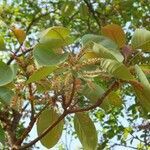| Therapeutic use
|
Allergens (bark), Anemia (bark), Antiemetics (bark), Asthma (bark), Common cold (bark), Cough (bark), Diuretics (bark), Hoarseness (bark), Urination disorders (bark), Vitiligo (bark), Allergens (fruit), Hair loss (fruit), Analgesics (fruit), Anemia (fruit), Antacids (fruit), Anthelmintics (fruit), Anti-bacterial agents (fruit), Antiemetics (fruit), Antipyretics (fruit), Asthenia (fruit), Asthma (fruit), Astringents (fruit), Avian myeloblastosis virus (fruit), Brain diseases (fruit), Bronchitis (fruit), Cathartics (fruit), Common cold (fruit), Conjunctivitis (fruit), Constipation (fruit), Cough (fruit), Diarrhea (fruit), Disinfectants (fruit), Dysentery (fruit), Dyspepsia (fruit), Edema (fruit), Expectorants (fruit), Eye diseases (fruit), Fever (fruit), Flatulence (fruit), Gastrointestinal diseases (fruit), Graves ophthalmopathy (fruit), Hair dyes (fruit), Headache (fruit), Hematologic diseases (fruit), Hemorrhage (fruit), Hemorrhoids (fruit), Hemostasis (fruit), Hemostatics (fruit), HIV-1 (fruit), Hoarseness (fruit), Inflammation (fruit), Jaundice (fruit), Laxatives (fruit), Leprosy (fruit), Leukorrhea (fruit), Liver diseases (fruit), Myocardial depressant factor (fruit), Neoplasms (fruit), Nasal disease (fruit), Pain (fruit), Pharyngitis (fruit), Pulmonary eosinophilia (fruit), General tonic for rejuvenation (fruit), Skin diseases (fruit), Sleep initiation and maintenance disorders (fruit), Spermatocidal agents (fruit), Splenomegaly (fruit), Thirst (fruit), Tuberculosis (fruit), Ulcer (fruit), Urination disorders (fruit), Vomiting (fruit), Wounds and injuries (fruit), Antiemetics (rhizome), Hair loss (seed), Hair diseases (seed), Hair dyes (seed), Narcotics (seed), Pain (seed), Skin diseases (seed), Thirst (seed), Urinary calculi (seed), Vomiting (seed), Bite(Snake) (unspecified), Fever (unspecified), Measles (unspecified), Myalgia (unspecified), Parturition (unspecified), Spasm (unspecified), Dysuria (unspecified), Narcotic (unspecified), Astringent (unspecified), Cholera (unspecified), Respiratory (unspecified), Tumor(Abdomen) (unspecified), Immunostimulant (unspecified), Aging (unspecified), Hair loss (unspecified), Analgesics (unspecified), Anemia (unspecified), Anorexia (unspecified), Antiemetics (unspecified), Anti-inflammatory agents (unspecified), Antipyretics (unspecified), Antirheumatic agents (unspecified), Arthritis (unspecified), Ascites (unspecified), Astringents (unspecified), Cough (unspecified), Dyspepsia (unspecified), Edema (unspecified), Disorder of ejaculation (unspecified), Eye diseases (unspecified), Gout (unspecified), Hair diseases (unspecified), Headache (unspecified), Hemostasis (unspecified), Hoarseness (unspecified), Hypoglycemic agents (unspecified), Laxatives (unspecified), Leprosy (unspecified), Liver diseases (unspecified), Nootropic agents (unspecified), Increase physical endurance, strength and stamina (unspecified), General tonic for rejuvenation (unspecified), Respiratory tract infections (unspecified), Skin diseases (unspecified), Vitiligo (unspecified), Anthelmintics (whole plant), Anti-infective agents (whole plant), Appetite stimulants (whole plant), Cataract (whole plant), Chronic disease (whole plant), Corneal opacity (whole plant), Eye diseases (whole plant), Flatulence (whole plant), Hemorrhoids (whole plant), Myopia (whole plant), Thirst (whole plant)
|


